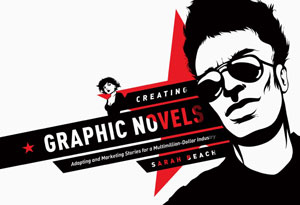Even though I was not able to do any panels or presentations myself at the convention (since I missed the deadline for those), I still enjoyed my time at the Wizard World Portland Comic Con. It gave me an opportunity to show the book around to various people as well as do some networking. Every convention has at least a few panels or presentations about writing.
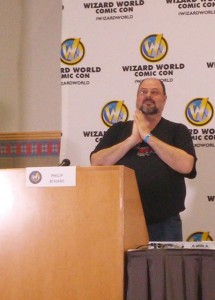
Philip Athans
The first presentation I attended was given by Philip Athans, about writing fantasy and science fiction. A former senior managing editor for Wizards of the Coast he had good advice to writers who are stepping into these genres. World-building is always a crucial element in convincing your readers to invest in your fictional world.
There’s a lot of cross-over between readers and writers of fantasy and science fiction and the creators of many graphic novels. It’s one reason why a presentation like this does very well at conventions. Athans managed to fill his time slot quite well, in addition to fielding a number of questions from aspiring writers in the audience.
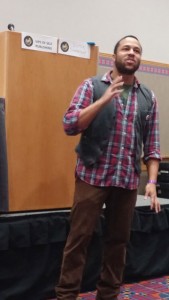
Victor Dandridge
From there I went on to a presentation titled “VIPs of Self-Publishing”, a discussion led by Victor Dandridge. This turned out to be a more casual interaction between Dandridge and those in the audience. He’s an engaging speaker and had plenty to say to the group, drawing from his own experiences in stepping out and publishing his own works, building his audience and getting attention for his titles. His enthusiasm for the activity was inspiring.
Since the time slot for this presentation ended at 7:15 pm, I took the opportunity to chat with Victor as we walked down to the Exhibit Hall. He has committed himself to getting his independent comics out into the marketplace, and I think he certainly has the drive to make an impression in the business.
Walking through Exhibit Hall, I had also taken the time to connect with a couple of friends who had tables in the Artists Alley. One was artist Steve Lieber (he’s a Portland resident, so I was sure I would see him). One of the nicest guys in the business, Steve is always a pleasure to talk to.
Another friend I stopped to chat with was Kurt Busiek. The man is an exceptional writer, whose stories I’ve always enjoyed. He was one of the featured guests of the convention. We chatted a bit about his new title “Tooth and Claw”. The book looks terrific, and should be checked out by readers.
Saturday began for me with the panel “How to Write Comics”.

L to R: Danny Fingeroth, Kurt Busiek, Michael Avon Oeming, Chris Gage, Brandon Seifert
Each of the gentlemen discussed various aspects of writing comics, from the variety of ways a comic/graphic novel script can be arranged (highlighted by comments from Fingeroth and Busiek), to the differences between scripting television and comics (Chris Gage speaking from his experiences). The panel also fielded questions from the audience.
Later in the day I attended a panel titled “The Future of Storytelling”, out of curiosity as to what they would have to say.
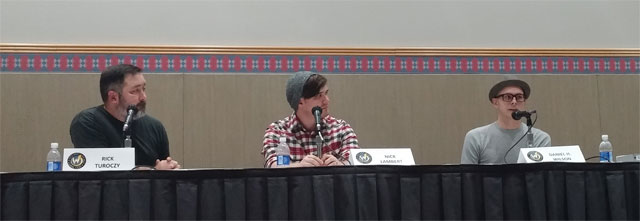
L to R: Rick Turoczy, Nick Lambert, and Daniel H. Wilson
Their presentation centered around the game they developed for the iPhone, “Mayday! Deep Space”. The innovations of their creation are that the game was given a degree of artificial intelligence, and that commands are delivered by voice (the app features voice recognition for play). The player is not the main character in the “story” of the game, but rather is advising the character in choices – and if you the player send the character down a corridor with a monster at the end of it, he’s going to turn and run away. The panelists discussed how this type of approach can change the way stories are created, due to the interactivity of the characters and the player/audience. Wilson posed the question about whether this would totally change the way stories are told. But most of the audience felt it would not, but rather would become just another way to tell stories, another tool in the arsenal.
In spite of not having a platform to launch myself from, attending the Portland convention was a good way to launch this year. In addition to the networking I did, I encountered a reader of my own book! She was in the audience for Victor Dandridge’s presentation. As it happened, she had just recently purchased the book online. Being at the convention gave me ideas for different presentations I could make at future conventions, covering areas that others do not.
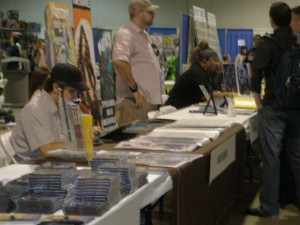
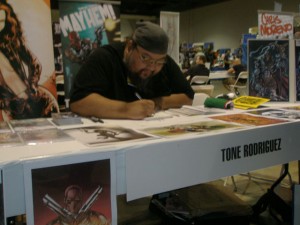

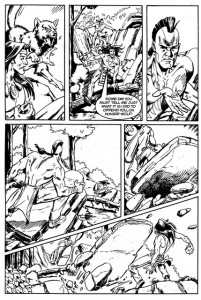 Thinking Visually
Thinking Visually




